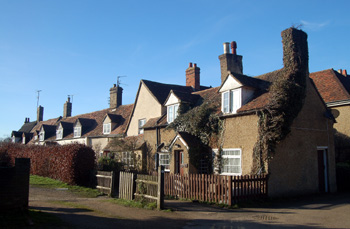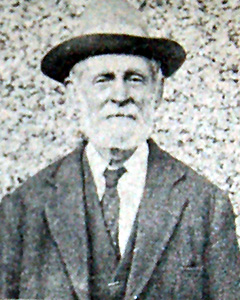20 to 30 School Lane Greenfield

20 to 30 School Lane February 2011
Numbers 20 to 30 School Lane form a long terrace at the end of School Lane, running roughly east to west. They were listed by the former Department of Environment in July 1975 as Grade II, of special interest. The department dated them to the 17th and 18th centuries.
The row is of timber-framed construction with pebbledash or colourwashed roughcast render. Most of the properties have clay tiled roofs, but Number 30, at the far end of the row, is thatched. The properties comprise one storey and attics. Number 20 is a later addition to the row at the east end. The listing says: "Rather irregular arrangement. Variety of doors and porches. Variety of brick ridge and gable end chimney stacks".
Numbers 18 to 30 School Lane were owned by the Wrest Park Estate. When the 9th Baron Lucas of Crudwell was killed in action on the Western Front with the Royal Flying Corps in December 1916 his sister Nan Ino succeeded him as 10th Baroness Lucas. She decided to break up and sell the estate and offered Numbers 18 to 30 School Lane to their tenants.
An Ordnance Survey map of 1970 shows a bizarre numbering for the row which goes, from east to west: 20 – 22 – 26 – 24 – 28 – 30. A plan of the row accompanying one of the conveyances of 1918 shows that Numbers 20 and 22 were occupied by Mrs. F. C. Clarke and Thomas Henry Arnold respectively. The next property was that numbered as 26 on the Ordnance Survey map, occupied by Mrs. E. R. Fountain. The next property was the largest, being Numbers 24 and 28 on the Ordnance Survey map and occupied by David M. Cherry. The smallest property, Number 30, was occupied by Ernest A. Sharp [L23/134].
The sales in 1918 were as follows:
- Mrs. F. C. Clarke - £45 [L23/136-139];
- Thomas Henry Arnold - £95 [L23/132-135];
- Mrs. E. R. Fountain - £45 [L23/129-131];
- David M. Cherry - £125 [L23/122-124];
- Ernest A. Sharp - £35 [L23/115-118].
The plan shows that Arnold's and Fountain's washhouses were set against the west wall of Number 30 and that a well stood immediately west of them. Arnold's first floor also overlapped Fountain's ground floor at the south-east corner of Fountain's cottage. Arnold's stairs had a cupboard of Clarke's beneath along the dividing line between the two properties. Arnold and Fountain also shared a small piece of garden belonging to 18 School Lane immediately north of Fountain's property. Clarke and Arnold each had half a piece of garden along a right of way some yards south of Clarke's property.
The Rating and Valuation Act 1925 specified that every building and piece of land in the country was to be assessed to determine its rateable value. The valuer visiting School Lane reported on each of the properties in the row as follows:
- 20 School Lane [DV1/C269/54]: owner and occupier Florence Clarke. Accommodation comprised a semi-detached living room, a kitchen and two bedrooms. A brick and tiled washhouse stood outside. The valuer commented: "Down lane" and "2 Dormers" and "Post Office". Florence Clarke became postmistress some time between 1922 and 1924, the previous postmistress having been Ruth Dudley and the office had been at her address – 42 High Street.
- 22 School Lane [DV1/C269/55]: owner and occupier Thomas Arnold. Accommodation comprised a kitchen, a living room and two bedrooms. There were "2 bits" of garden. The valuer commented: "gable and dormer".
- 26 School Lane [DV1/C269/56]: owner and occupier W. Fountain. Accommodation comprised a living room, a washhouse, a bedroom and a box room. The valuer commented: "Dormer" and, rather puzzlingly "at end of row". A brick and slate store place with a loft over was used as a second bedroom.
- 24 School Lane [DV1/C269/57]: owner H. Cherry, occupier Mrs. A. Ashton who paid rent of £3/10/- per annum. This was presumably a subdivision of Cherry's property bought in 1918, which was about twice the size of any of the other dwellings in the row at the time. Accommodation comprised a living room, a washhouse, a bedroom and a box room. The valuer commented: "Dormer".
- 28 School Lane [DV1/C269/58]: owner H. Cherry occupier J. Cherry. Accommodation comprised two living rooms, a kitchen and three bedrooms in roof. The valuer commented: "used to be 2", and "two dormers". At the time of the valuation the cottage was thatched. Given that Mrs. Ashton's accommodation had been carved out of Number 28 the two cottages referred to by the valuer would have had two rooms downstairs each (one with one of 28's living rooms and its kitchen and one with one of 28's living rooms and 24's living room).
- 30 School Lane [DV1/C269/59]: owner E. Sharp, occupier W. Sharp at a rent of £5 per annum. Accommodation comprised a kitchen, a washhouse and a bedroom. The valuer noted: "half wash house at end of row" – evidently he had taken over the half which belonged to either Arnold or Fountain (see above). The valuer also commented: "Dormer".

William Sharp in 1932
The Bedfordshire Times of 12th February 1932 carried an article of interviews with old people in Greenfield. one of them was William Sharp: "Another interesting personality who has spent most of his 80 years in the village is Mr. William Sharp of Countess Row. He is the eldest of a family of eleven children and was born at Maulden. At a tender age he began to augment the family income by assisting with straw plaiting. He never went to school, with the exception of a night class at which plaiting was the only subject. His first job was with a market gardener when he was seven; his wages were a shilling a week and his dinner on Sundays. He still had to assist with the plaiting in his spare time and when bad weather put a stop to outdoor work. After working on a farm Mr. Sharp got a job at Wrest Park, Silsoe, but left that to go as an apprentice to the trade of painting and glazing, at which he remained for nineteen years. After an illness a friend let him a few acres of land, but as he could not get on very well at his new job he gave it up and returned to his trade, at which still works. He has been married twice and has two children".
"During the 68 years spent in the village Mr. Sharp does not recollect many changes, though there are a few more houses. A life-long Wesleyan, he has the fine record of 57 years as a teacher and Superintendent of the Sunday School, and he regularly plays the organ there. When he first joined the chapel there was no heating or instrumental music and with others he was able to raise the funds necessary for the provision of both. Since he has been connected with the chapel a new schoolroom has been added, and other improvements have been carried out. recalling his youth Mr. Sharp said that he had no desire to return to the good old days when his wages were three shillings a week; later, when he was married, he had fourpence for pocket money. Many mornings, he declared, he had gone and eaten blackberries when he had not had enough breakfast, and he was certainly more contented now that he had plenty".
""If people live any harder today than we did then, woe betide them!" he said. Mr. Sharp is able to read and write. He is remarkably active for his age, and in the course of his work he still goes up a ladder when necessary. "Living hard" does not apear to have affected him, much, and he enjoys a quiet chat with his old friend Mr. Holmes". Flitton parish registers reveal that William Sharp was buried on 3rd December 1934, aged 83.